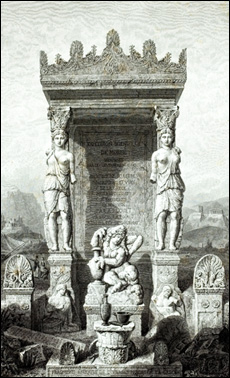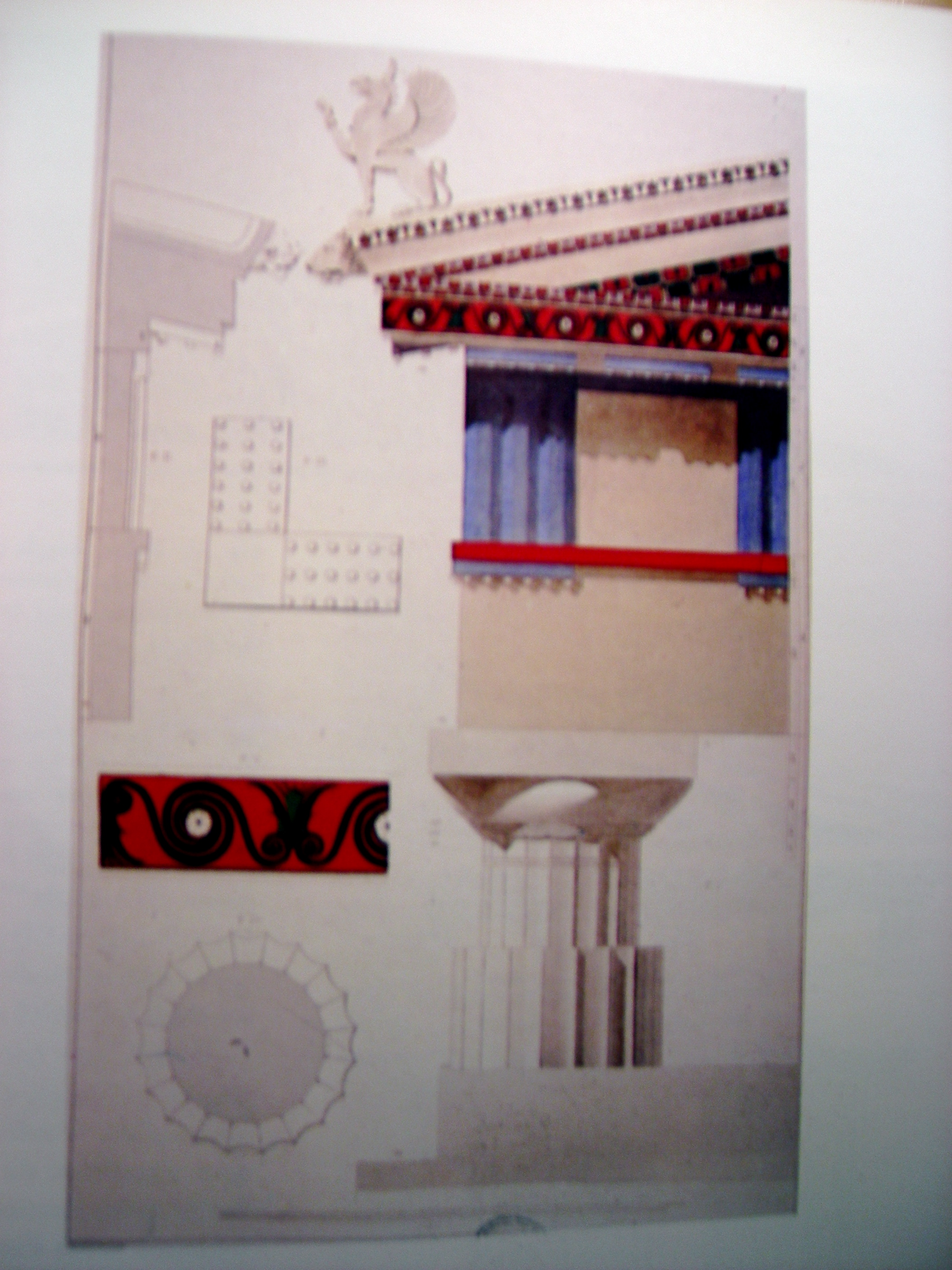Abel Blouet on:
[Wikipedia]
[Google]
[Amazon]


 Guillaume-Abel Blouet (; 6 October 1795 – 7 May 1853) was a French architect who specialised in prison design.
Guillaume-Abel Blouet (; 6 October 1795 – 7 May 1853) was a French architect who specialised in prison design.
/ref> In 1846 he was appointed a professor at the
''Restauration des thermes d'Antonin Caracalla, à Rome, présentée en 1826 et dédiée en 1827 à l'Académie des Beaux-Arts''
(1828)
''Expedition scientifique de Morée ordonnée par le Gouvernement Français; Architecture, Sculptures, Inscriptions et Vues du Péloponèse, des Cyclades et de l'Attique'', mesurées, dessinées, recueillies et publiées
(Abel Blouet, with Amable Ravoisié, Achille Poirot, Félix Trézel and Frédéric de Gournay) (3 volumes, 1831–1838)
''Rapports à M. le Comte de Montalivet, sur les pénitenciers des États-Unis''
by
''Chutes du Niagara''
(
''Instruction Et Programme Pour La Construction Des Maisons D'ArrĂŞt Et De Justice: Atlas De Plans De Prisons Cellulaires''
by Abel Blouet, and (1841)Noted in Van Zanten 1989:17.
''Projet de prison cellulaire pour 585 condamnés, précédé d'Observations sur le système pénitentiaire''
(1843) The design had been shown at the
''Traité théorique et pratique de l'art de bâtir''
by
''Supplément''
(plates) by G.-Abel Blouet (1847)


Biography
Blouet was born atPassy
Passy () is an area of Paris, France, located in the 16th arrondissement of Paris, 16th arrondissement, on the Rive Droite, Right Bank. It is adjacent to Auteuil, Paris, Auteuil to the southwest, and Chaillot to the northeast.
It is home to many ...
. He won the Grand Prix de Rome
The Prix de Rome () or Grand Prix de Rome was a French scholarship for arts students, initially for painters and sculptors, that was established in 1663 during the reign of Louis XIV of France. Winners were awarded a bursary that allowed them t ...
in 1821 at the École des Beaux-Arts
; ) refers to a number of influential art schools in France. The term is associated with the Beaux-Arts architecture, Beaux-Arts style in architecture and city planning that thrived in France and other countries during the late nineteenth centu ...
, entitling him to five years of study at the French Academy in Rome
The French Academy in Rome (, ) is an academy located in the Villa Medici, within the Villa Borghese, on the Pincio (Pincian Hill) in Rome, Italy.
History
The Academy was founded at the Palazzo Capranica in 1666 by Louis XIV under the dire ...
. The study of Roman architecture that was expected from students at the French Academy at Rome
The French Academy in Rome (, ) is an academy located in the Villa Medici, within the Villa Borghese, on the Pincio (Pincian Hill) in Rome, Italy.
History
The Academy was founded at the Palazzo Capranica in 1666 by Louis XIV under the direct ...
resulted in his speculative restoration of the original construction of the Baths of Caracalla
The Baths of Caracalla () in Rome, Italy, were the city's second largest Ancient Rome, Roman public baths, or ''thermae'', after the Baths of Diocletian. The baths were likely built between AD 212 (or 211) and 216/217, during the reigns of empero ...
, ''Restauration des thermes d'Antonin Caracalla, à Rome, présentée en 1826 et dédiée en 1827 à l'Académie des Beaux-Arts'' (1828).
The Institut de France
The ; ) is a French learned society, grouping five , including the . It was established in 1795 at the direction of the National Convention. Located on the Quai de Conti in the 6th arrondissement of Paris, the institute manages approximately ...
appointed Blouet the head of the fine arts section of the French Morea expedition
The Morea expedition () is the name given to the land intervention of the French Army in the Peloponnese between 1828 and 1833, at the time of the Greek War of Independence, with the aim of expelling the Ottoman-Egyptian occupation forces from ...
1828–1833, the second of three great military-scientific expeditions led by France in the first half of the 19th century, in which geologists and antiquarians accompanied an expedition with military objectives, in this case to deport all Ottoman nationals from the Morea
Morea ( or ) was the name of the Peloponnese peninsula in southern Greece during the Middle Ages and the early modern period. The name was used by the Principality of Achaea, the Byzantine province known as the Despotate of the Morea, by the O ...
, a turning-point in the Greek War of Independence
The Greek War of Independence, also known as the Greek Revolution or the Greek Revolution of 1821, was a successful war of independence by Greek revolutionaries against the Ottoman Empire between 1821 and 1829. In 1826, the Greeks were assisted ...
. In the course of the expedition he established the identity of the Temple of Zeus at Olympia (1829), which was measured and carefully drawn and published.
Having overseen the completion of the Arc de Triomphe
The Arc de Triomphe de l'Étoile, often called simply the Arc de Triomphe, is one of the most famous monuments in Paris, France, standing at the western end of the Champs-Élysées at the centre of Place Charles de Gaulle, formerly named Plac ...
(1831–36), he toured the United States in 1836, together with Frédéric-Auguste Demetz
Frédéric-Auguste Demetz (1796–1873) was a French penal reformer and jurist. He toured the United States in 1836, together with the architect Guillaume-Abel Blouet, to study progressive American Prison design, prison architecture and administra ...
, a penal reformer and lawyer at the French Royal Court, to study American prison architecture and administration for the French Ministry of the Interior.
Upon Blouet's return to Paris he devoted himself to the reform of prison design and in 1838 was appointed to the new post of Inspector General of French Prisons, which brought with it, ''ex officio'', a seat on the Conseil des bâtiments civiles, the official national body that succeeded the Bâtiments du Roi The Bâtiments du Roi (, 'King's Buildings') was a division of the Maison du Roi ('King's Household') in France under the Ancien Régime. It was responsible for building works at the King's residences in and around Paris.
History
The Bâtiments ...
of the Ancien RĂ©gime. Blouet believed in using architecture to realize social reform and together with Demetz worked on the design and layout of the buildings for the Mettray Penal Colony, an agricultural reform school
A reform school was a Prison, penal institution, generally for teenagers, mainly operating between 1830 and 1900. In the United Kingdom and its colonies, reformatory, reformatories (commonly called reform schools) were set up from 1854 onward f ...
, which was initially directed by Demetz after its opening in July 1839. It was noted as being officially opened on 22 January 1840."Model prisons", ''The New York Times'', 25 August 1873/ref> In 1846 he was appointed a professor at the
École nationale supérieure des Beaux-Arts
École or Ecole may refer to:
* an elementary school in the French educational stages normally followed by secondary education establishments (collège and lycée)
* École (river), a tributary of the Seine
The Seine ( , ) is a river in nor ...
, where his pupils included Jules Pellechet. In 1848, when his post of Inspector General of Prisons was eliminated in a reorganization, he was given in compensation the position of architect in charge of the Palais de Fontainebleau, which was to be a center of court life under the French Second Empire
The Second French Empire, officially the French Empire, was the government of France from 1852 to 1870. It was established on 2 December 1852 by Louis-Napoléon Bonaparte, president of France under the French Second Republic, who proclaimed hi ...
. He revised and completed the ''Traité théorique et pratique de l'art de bâtir'' of Jean-Baptiste Rondelet
Jean-Baptiste Rondelet (; 4 June 1743 – 25 September 1829) was an architectural theorist of the late Enlightenment era and chief architect of the church of Sainte-Geneviève after the death of Jacques Germain Soufflot of cancer in 1780.
R ...
(1847). He was elected to the Académie des Beaux-Arts
The (; ) is a French learned society based in Paris. It is one of the five academies of the . The current president of the academy (2021) is Alain-Charles Perrot, a French architect.
Background
The academy was created in 1816 in Paris as a me ...
in 1850.
He died in Paris in 1853.
Principal publications
''Restauration des thermes d'Antonin Caracalla, à Rome, présentée en 1826 et dédiée en 1827 à l'Académie des Beaux-Arts''
(1828)
''Expedition scientifique de Morée ordonnée par le Gouvernement Français; Architecture, Sculptures, Inscriptions et Vues du Péloponèse, des Cyclades et de l'Attique'', mesurées, dessinées, recueillies et publiées
(Abel Blouet, with Amable Ravoisié, Achille Poirot, Félix Trézel and Frédéric de Gournay) (3 volumes, 1831–1838)
''Rapports à M. le Comte de Montalivet, sur les pénitenciers des États-Unis''
by
Frédéric-Auguste Demetz
Frédéric-Auguste Demetz (1796–1873) was a French penal reformer and jurist. He toured the United States in 1836, together with the architect Guillaume-Abel Blouet, to study progressive American Prison design, prison architecture and administra ...
and Abel Blouet (1837)
''Chutes du Niagara''
(
Niagara Falls
Niagara Falls is a group of three waterfalls at the southern end of Niagara Gorge, spanning the Canada–United States border, border between the Provinces and territories of Canada, province of Ontario in Canada and the state of New York (s ...
), drawn from nature in March 1837 by A. Blouet, lithographed by C. Remond (1838)
''Instruction Et Programme Pour La Construction Des Maisons D'ArrĂŞt Et De Justice: Atlas De Plans De Prisons Cellulaires''
by Abel Blouet, and (1841)Noted in Van Zanten 1989:17.
''Projet de prison cellulaire pour 585 condamnés, précédé d'Observations sur le système pénitentiaire''
(1843) The design had been shown at the
Paris Salon
The Salon (), or rarely Paris Salon (French: ''Salon de Paris'' ), beginning in 1667 was the official art exhibition of the in Paris. Between 1748 and 1890 it was arguably the greatest annual or biennial art event in the Western world. At the ...
of 1843.
''Traité théorique et pratique de l'art de bâtir''
by
Jean-Baptiste Rondelet
Jean-Baptiste Rondelet (; 4 June 1743 – 25 September 1829) was an architectural theorist of the late Enlightenment era and chief architect of the church of Sainte-Geneviève after the death of Jacques Germain Soufflot of cancer in 1780.
R ...
, 5 volumes (1802-1817).''Supplément''
(plates) by G.-Abel Blouet (1847)
Notes
External links
{{DEFAULTSORT:Blouet, Guillaume-Abel 1795 births 1853 deaths Architects from Paris 19th-century French architects Prix de Rome for architecture École des Beaux-Arts alumni Members of the Académie des beaux-arts